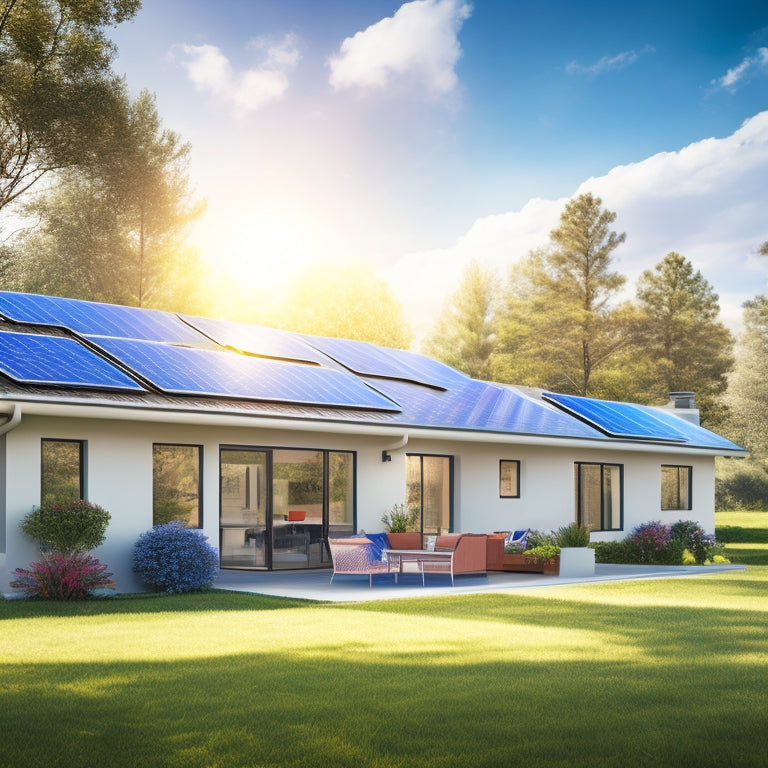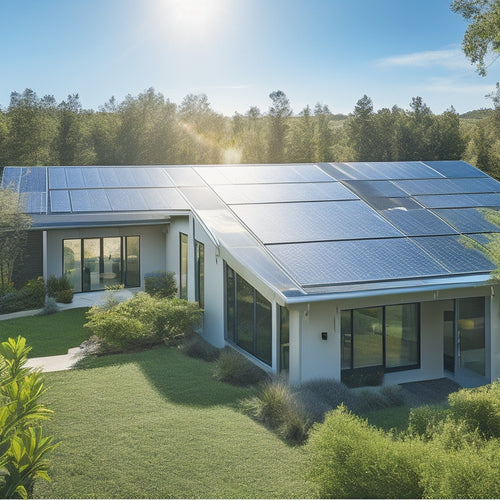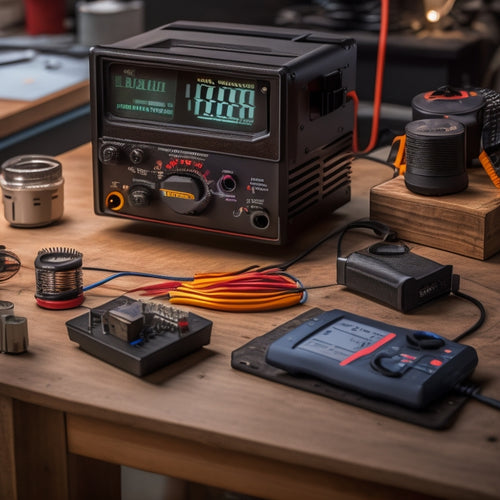
Solar Power for Home Cooling Systems
Share
You're considering utilizing solar power to cool your home, and that's a smart move, as this renewable energy source can greatly reduce your reliance on traditional power grids and lower your energy bills. Solar cooling systems use photovoltaic or solar thermal technology to generate electricity or heat, which is then used to power absorption chillers or vapor-compression systems. With proper system design, installation, and maintenance, you can enjoy energy independence, environmental sustainability, and considerable cost savings. Now that you've taken the first step, you'll want to investigate the various system configurations, panel options, and incentives available to optimize your solar cooling setup.
Key Takeaways
- Solar cooling systems offer energy independence, reducing reliance on traditional energy sources and minimizing greenhouse gas emissions.
- There are two primary methods of solar cooling: solar thermal, which uses heat for absorption chillers, and photovoltaic, which generates electricity for vapor-compression systems.
- Solar panels generate electricity to power cooling systems, involving thermodynamics and heat transfer, with refrigerant circulation absorbing heat from the home and releasing it outside.
- System design considerations include energy requirements, configuration and integration, and hybrid systems and storage options to ensure a reliable energy supply.
- Regular maintenance is crucial for efficient operation, involving routine inspections, cleaning, and performance monitoring to maintain system performance and identify potential issues early.
Harnessing Solar Energy for Cooling
As you investigate the potential of solar power for home cooling systems, utilizing solar energy for cooling becomes an important aspect to take into account.
You'll find that there are two primary methods for utilizing solar energy for cooling: solar thermal and photovoltaic cooling. In addition, it's vital to evaluate the efficiency of solar panel battery chargers high-efficiency solar charging solutions and the reliability of off-grid power systems to guarantee a consistent energy supply.
Solar thermal systems use heat from the sun to power absorption chillers, which provide cooling. Photovoltaic cooling, on the other hand, involves using solar panels to generate electricity, which is then used to power traditional vapor-compression cooling systems.
Both methods offer unique advantages and can be integrated into your home cooling system. By understanding the differences between these approaches, you can make an informed decision about which one suits your cooling needs.
Benefits of Solar Cooling Systems
You've likely considered the different methods for utilizing solar energy for cooling, and now it's time to investigate the benefits that come with integrating solar cooling systems into your home.
By capturing the power of the sun, you can reduce your reliance on traditional energy sources and achieve energy independence. This, in turn, reduces your environmental impact by minimizing greenhouse gas emissions and conserving natural resources.
Off-grid solar battery systems can further enhance energy independence, leading to lower energy bills and increased energy security.
Additionally, solar cooling systems can provide significant cost savings by reducing your energy bills.
With solar cooling, you can stay cool and comfortable while also doing your part for the environment.
How Solar Cooling Works
You're about to uncover how solar cooling works, and it all starts with understanding the fundamental principles of solar-powered cooling systems.
These principles, which include thermodynamics and heat transfer, are vital in designing an efficient system that can effectively cool your home.
By grasping these principles and evaluating key system design factors, you'll be well on your way to utilizing the power of the sun to cool your living space.
As you investigate solar energy solutions, keep in mind that Energy Monitoring Systems can provide useful observations into your energy consumption patterns.
Additionally, it's important to reflect on sustainable insulation options, such as recycled denim or natural wool, to minimize heat loss and energy waste.
Solar Cooling Principles
Utilizing the sun's energy to cool your home is a highly efficient and environmentally friendly alternative to traditional air conditioning systems.
You can capture the sun's energy through solar panels, which generate electricity to power a cooling system. The cooling process involves the circulation of a refrigerant, which absorbs heat from your home and releases it outside.
This process can be enhanced through passive cooling techniques, such as shading, insulation, and natural ventilation, which reduce the heat gain in your home.
Additionally, thermal storage systems can store cool energy during the night and release it during the day, reducing the load on your cooling system.
System Design Considerations
When designing a solar cooling system, several key considerations come into play to secure efficient and effective operation.
You'll need to assess your energy requirements, taking into consideration factors like climate, insulation, and window orientation.
Next, determine the ideal system configuration, including the size and type of solar panels, cooling technology, and energy storage solutions.
System integration strategies are essential, as they guarantee seamless interaction between components.
Consider hybrid systems that combine solar power with traditional energy sources to guarantee a reliable supply.
Additionally, evaluate energy storage options, such as batteries, to address intermittency and provide backup during periods of low sunlight.
Choosing the Right Solar Panels
When selecting solar panels for your home cooling system, you'll need to contemplate two critical factors: panel efficiency ratings and mounting type options.
Efficiency ratings, measured in percentages, indicate how well a panel converts sunlight into electricity, and higher ratings generally mean more power output per unit area.
Panel Efficiency Ratings
Your solar panel selection hinges on a critical factor: panel efficiency ratings. This metric determines how effectively your solar panels convert sunlight into electricity. A higher efficiency rating means more power per unit area, which can notably impact your home cooling system's performance.
When comparing panel technologies, consider the following key factors:
-
Monocrystalline silicon panels offer high efficiencies (up to 22%) but come at a higher cost.
-
Polycrystalline silicon panels provide a balance between efficiency (15-18%) and affordability.
-
Thin-film panels have lower efficiencies (7-14%) but are more budget-friendly and flexible.
Mounting Type Options
The rooftop real estate occupied by your solar panels is just as essential as the panels themselves, as the mounting type can greatly impact energy production and overall system durability.
You'll need to take into account factors like roof size, orientation, and structural integrity when selecting a mounting type. Roof mounted systems are the most common, but ground mounted systems offer more flexibility.
Pole mounted systems raise panels above obstructions, while tracking systems optimize energy production by following the sun's movement.
Hybrid systems combine different mounting types, and portable installations provide off-grid solutions. Building integrated systems seamlessly integrate panels into your roof, ensuring a sleek appearance.
Cooling System Installation Tips
Proper planning and execution are essential to a successful solar-powered cooling system installation.
You'll want to guarantee that your system is compatible with your home's electrical infrastructure and that the installation process is done correctly.
Some key considerations to keep in mind during the installation process include:
- Guaranteeing that your solar panels are properly sized to meet your cooling system's energy demands
- Verifying that your system is compatible with local building codes and regulations
- Conducting a thorough inspection of your home's electrical system to identify potential issues before installation begins
Maintenance and Troubleshooting
How efficiently your solar-powered cooling system operates over time largely depends on regular maintenance and prompt troubleshooting. To guarantee peak performance, you should perform routine inspections to identify and address common issues before they escalate. Create a maintenance schedule to stay on track, and consider system upgrades to improve efficiency.
| Task | Frequency | Description |
|---|---|---|
| Component cleaning | Monthly | Remove dust and debris from solar panels and cooling system components |
| Performance monitoring | Quarterly | Check system performance and identify areas for efficiency optimization |
| Seasonal preparations | Bi-annually | Prepare your system for seasonal changes to guarantee seamless operation |
| Troubleshooting | As needed | Identify and address common issues using proven troubleshooting techniques |
| Repair and maintenance | As needed | Follow repair tips and guidelines to minimize downtime and guarantee proper system function |
Cost Savings and Incentives
By keeping your solar-powered cooling system in top shape, you'll reap the benefits of lower energy bills and a reduced carbon footprint. This translates to considerable cost savings over time.
To sweeten the deal, you can take advantage of various financial incentives offered by governments and utility companies.
-
Enjoy tax credits of up to 30% of your installation costs, reducing your tax liability and increasing your return on investment.
-
Benefit from utility rebates that can offset a substantial portion of your upfront costs.
-
Tap into government programs that provide low-interest financing options, making it easier to go solar.
These incentives can considerably reduce the payback period of your solar-powered cooling system, making it a smart investment for your wallet and the environment.
Frequently Asked Questions
Can I Use Solar Power for Both Cooling and Heating My Home?
You're wondering if you can utilize solar power for both cooling and heating - the answer is yes! By leveraging solar thermal technology, you can achieve energy efficiency and reduce your reliance on traditional energy sources.
Do Solar Cooling Systems Work During Power Outages?
During power outages, you'll maintain energy independence with solar cooling systems that store excess energy, ensuring continuous operation and ideal system efficiency, as long as your system is designed with a battery backup and proper grid disconnect functionality.
Are Solar Cooling Systems Compatible With Existing HVAC Systems?
You'll be intrigued to know that 75% of commercial buildings can benefit from solar technology integration. When it comes to your existing HVAC system, you'll find that solar cooling systems are indeed compatible, offering seamless integration and revealing energy efficiency benefits that reduce your energy bills.
Can I Install a Solar Cooling System Myself?
While you can attempt a DIY installation, it's essential you have extensive knowledge of solar system components, electrical connections, and local building codes to guarantee a safe and efficient setup, which can be challenging without professional proficiency.
Are There Any Noise Pollution Concerns With Solar Cooling Systems?
As you ponder the hum of technology, you'll find that solar cooling systems are designed with noise reduction in mind, ensuring a peaceful coexistence with nature while minimizing environmental impact, a harmonious melody for your ears and the planet.
Related Posts
-

Fastest Solar Chargers for Emergency Power
When choosing the fastest solar chargers for emergency power, you need to focus on features like rapid charging capab...
-

Installing Metal Solar Roofs for Maximum Energy Efficiency
Installing metal solar roofs can drastically enhance your home's energy efficiency and durability. These roofs withst...
-

Key Features of a DC to AC Converter
A DC to AC converter features high efficiency and conversion rates, which reduce energy costs and improve performance...


